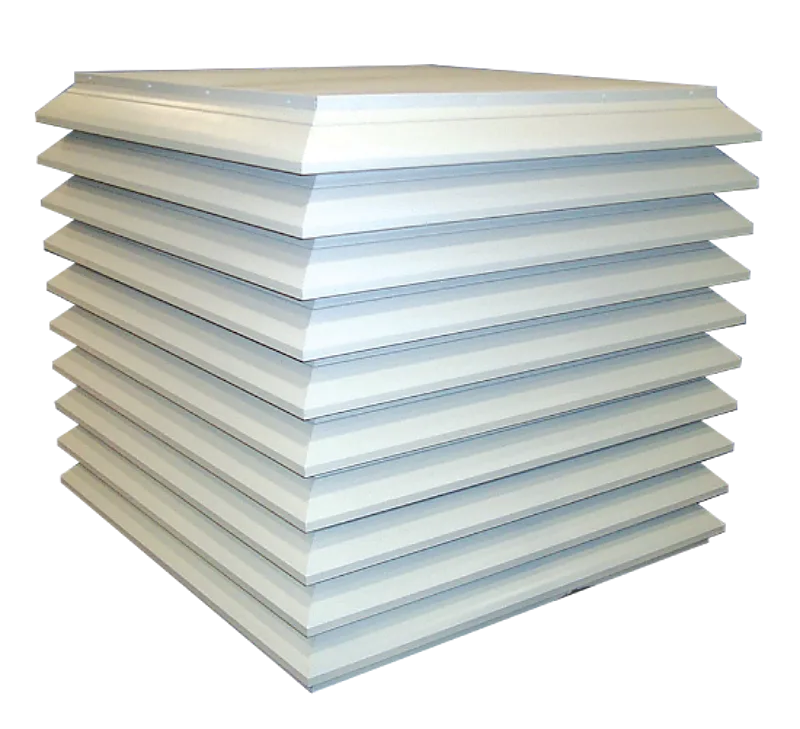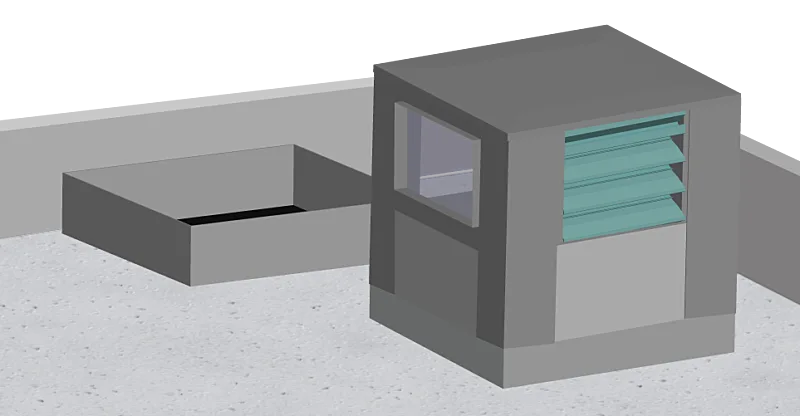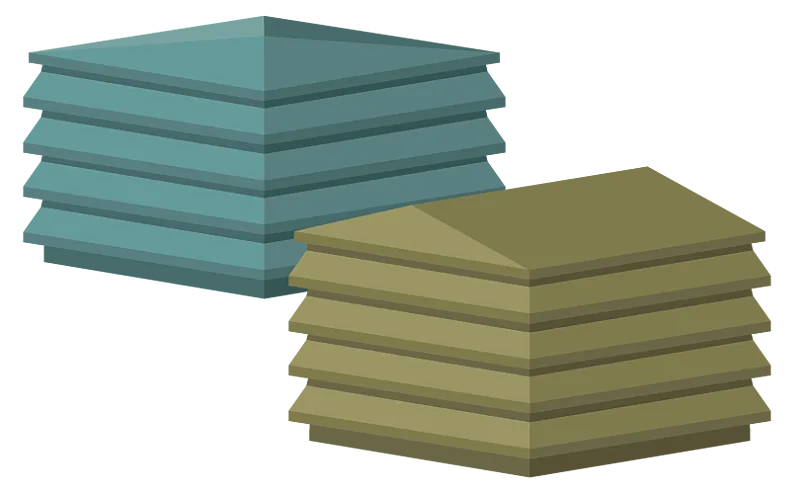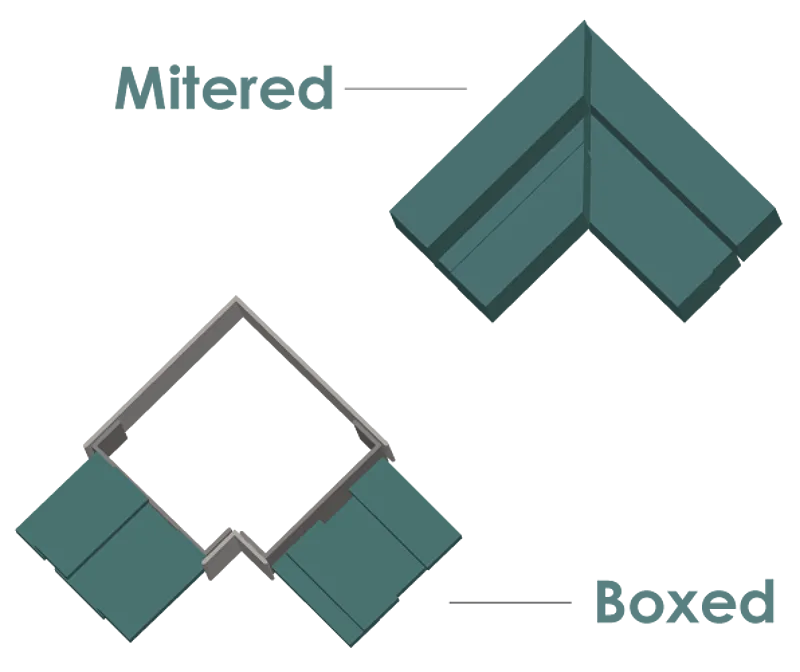Rooftop ventilation is common in urban projects, where there is very little horizontal space to work with. City buildings can still have ventilation openings along their façades, which are protected by louvers, but they will also have openings on the roof for airflow.
Rooftop openings are made along a horizontal plane. You can’t place a standard louver here. The louver's design only works on a vertical plane, like a wall opening. For the roof, you need a penthouse with louvered walls.

What is a Penthouse?
A penthouse is an assembly with four walls and a roof. Each wall can be solid or louvered, depending on what you need the penthouse to do. There will be at least one louvered wall. The blades of these walls can be drainable or non-drainable, with additional options for straight or baffled blades.
The completed assembly will sit over the opening when installed, typically with a throat accessory that rests inside the opening. The penthouse will cover the full ventilation opening. With the penthouse in place, the opening can still receive air through the louvered walls while staying protected from rainfall by the roof and the drainable blades.

How do you design a penthouse?
Sizing a penthouse is more complicated than sizing a standard louver. First, the penthouse length and width are measured along the bottom of the assembly, or the curb. For penthouses with throat accessories, you will be measuring the outer dimensions of the throat so that it fits in the roof opening. You will not be sizing the individual panels of the penthouse.
You will measure the width and length dimensions along the floor of the penthouse, not the walls. Think of it like measuring the floor of a room.
You will also need to determine the penthouse height, which is important for the louvers. Louver panels will need to be large enough to accept the required amount of airflow into the opening. Manufacturers will provide a list of recommended penthouse heights depending on the amount of airflow needed.
You will want the height to be no more than half the shortest curb size. If you have a penthouse that is 32” x 24”, then the height of the penthouse should be no more than twelve inches.
This is a general rule. The conditions at the installation site will dictate the required length, width, and height of the penthouse. Remember, the project’s requirements always come first in design.
Now that you have the size, it’s time to think about your other options.

What options are available for a penthouse?
There are additional options available for penthouses, like corners, roofs, and throat attachments.
We mentioned the walls before. You can have louvers set on each of the four walls, or on one of the walls of the penthouse, or louvers on two walls. If one side of the penthouse faces a wall, it may be better to have a solid wall for that side. It all depends on what you want the penthouse to do and the surrounding area.
Certain penthouse models will offer a choice on blade type for each louver panel. Make sure that the penthouse will provide the right level of protection for the opening.
All penthouses will offer a flat or pitched roof. The “flat” roof isn’t entirely flat. The panels of the roof are angled slightly to prevent rainwater from collecting on the roof. The pitched roof provides a steeper angle for water to slide off.
At AWV, we use the flat roof as a standard for penthouses with a curb opening of 72” or smaller and a standard pitched roof for penthouses with larger curb openings.

Next, let’s talk about the corners of the penthouse. Most penthouses will use boxed corners as a standard feature. Boxed corners use a metal cap piece to form each corner of the penthouse. These posts will be attached to each side of every wall, forming structural supports.
This gives the finished product a boxy, sturdy look. You can also choose mitered corners.
Mitered corners work best for penthouses with louvers on all four sides. The blades of each louver panel meet at the corners. Manufacturers miter-weld the blades together to create a blade profile that seems to stretch across each face of the penthouse.
This gives the finished assembly a continuous and overall sleeker look across each face of the assembly. Manufacturers will typically divide boxed and mitered corners into separate models.

The throat accessory goes into the opening and helps join the penthouse to the ductwork underneath. You can add a control damper to the throat to provide a shut off point at the opening or leave the throat open for airflow.
The throat will be fastened to the opening, along with the curb of the penthouse, so that everything stays secure during standard operation.
Penthouse Maintenance
Like any other HVAC product, it’s important to establish a regular maintenance schedule for your penthouses. Make sure their louvered faces are clean and clear of debris. Ensure all fasteners are secured and undamaged.
If the penthouse has a damper, be sure the damper opens and closes properly. That means smooth blade rotation with the actuator. These simple steps ensure that air moves freely through the penthouse.
Rooftop Ventilation with Penthouses
Protect your rooftop openings with penthouses. It’s important for air to flow through the openings, without risking water damage from rainfall. These assemblies keep your openings dry without restricting airflow.
AWV and Penthouses
Let AWV build the right penthouse for your next project. We offer penthouse assemblies with boxed or mitered corners for a wide range of projects. Visit our catalog online to see all your options, then contact AWV today. We would love to help you find the right penthouses for your building.





